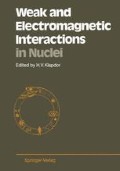Abstract
The question whether the neutrino possesses a finite rest mass remains one of the most important and challenging issues in todays physics. Unfortunately, there is little guidance from theory. Whereas in the minimal version of Grand Unified Theories — the SU(5) model — there is no room for neutrino mass generating processes, extended models beyond SU(5) easily allow neutrino masses in the range 10-6 eV to 10 eV. A finite neutrino mass together with violation of lepton number conservation offers the possibility of neutrino oscillations [1]. The underlying assumption for the existence of v — oscillations is, that the neutrino v ℓ being created and detected by weak interaction processes are coherent superpositions of neutrino states v i with definite mass mi, in analogy to the KM — mixing of hadronic charged currents:
where U ℓ,i are the mixing amplitudes. In the simplest picture, where only two neutrino species are involved, neutrino oscillations are characterized by two parameters: the mixing angle Θ, denoting the degree of admixture of the neutrino mass eigenstates to the weak eigenstates and the mass parameter Δm2 = |m1 2 – m2 2| defined by the difference of the squared corresponding mass eigenvalues.
Access this chapter
Tax calculation will be finalised at checkout
Purchases are for personal use only
Preview
Unable to display preview. Download preview PDF.
References
S.M. Bilenky et al.: Phys.Rep. C41, 225 (1978)
V. Zacek et al.: Phys.Lett. 164B, 193 (1985)
F. v. Feilitzsch et al.: Phys.Lett. 118B, 162 (1982)
P. Vogel et al.: Phys.Rev. C24, 1543 81981)
H.V. Klapdor et al.: Phys.Rev.Lett. 48, 127 (1982)
J.F. Cavaignac et al.: Phys.Lett. 148B, 387 (1984)
A. Afonin et al.: JETP Lett. 42, 285 (1985)
A. Pomansky: Proc. of the ν′86 Conference, Sendai, to be published
H. Sobel: Proc of the VIth Moriond Workshop on “Massive Neutrinos in Particle and Astrophysics”, edition Frontieres, (Feb. 1986)
Author information
Authors and Affiliations
Editor information
Editors and Affiliations
Rights and permissions
Copyright information
© 1986 Springer-Verlag Berlin Heidelberg
About this paper
Cite this paper
Zacek, V. (1986). Neutrino Oscillation Experiments at Nuclear Power Reactors. In: Klapdor, H.V. (eds) Weak and Electromagnetic Interactions in Nuclei. Springer, Berlin, Heidelberg. https://doi.org/10.1007/978-3-642-71689-8_147
Download citation
DOI: https://doi.org/10.1007/978-3-642-71689-8_147
Publisher Name: Springer, Berlin, Heidelberg
Print ISBN: 978-3-642-71691-1
Online ISBN: 978-3-642-71689-8
eBook Packages: Springer Book Archive

